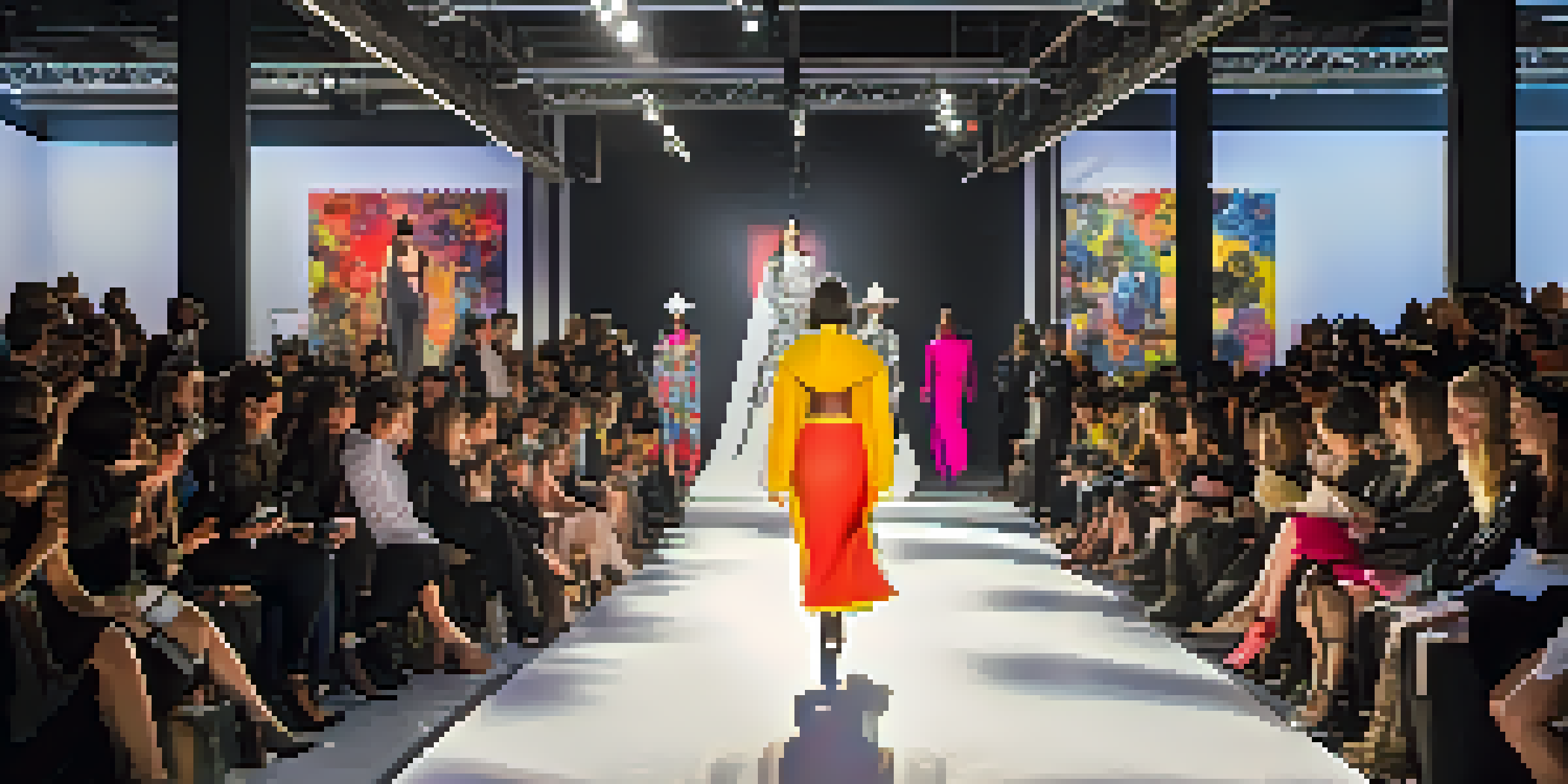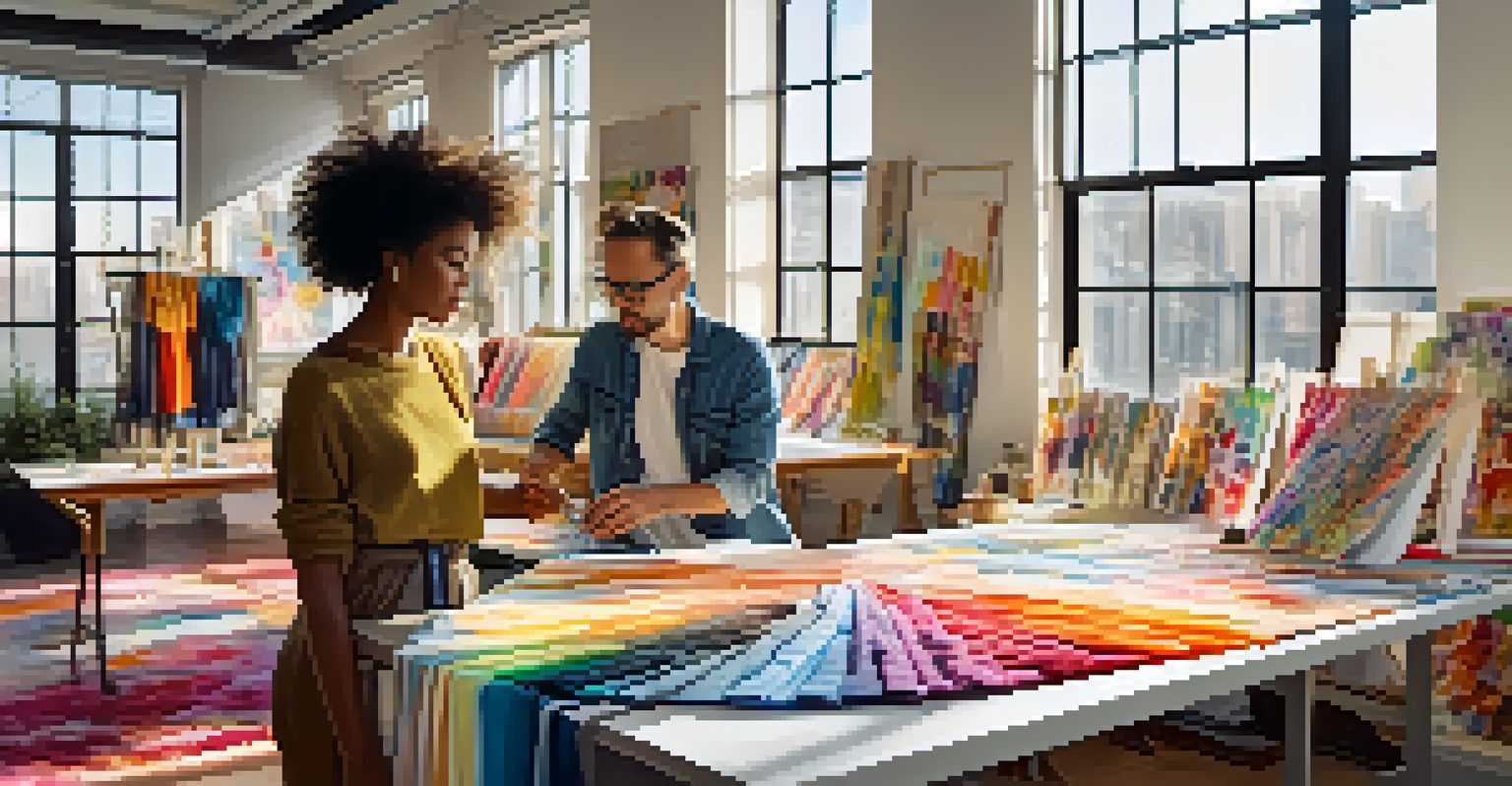The Intersection of Fashion and Art: Innovations in Design

The Historical Relationship Between Fashion and Art
Fashion and art have been intertwined for centuries, with each influencing the other. From the opulent gowns of the Renaissance to the bold designs of modern streetwear, artistic movements have shaped fashion trends. For instance, the Impressionist movement not only inspired painters but also influenced textile patterns and clothing designs.
Fashion is the armor to survive the reality of everyday life.
This historical connection showcases how artists and designers often draw inspiration from one another. Artists like Yves Saint Laurent famously used art as a muse, creating collections that echoed the styles of renowned painters, such as Mondrian. Such collaborations highlight the cyclical nature of these two fields, where one continually informs and redefines the other.
As we explore this relationship further, we see how contemporary designers are now merging artistic techniques into their fashion lines. This ongoing dialogue between fashion and art continues to evolve, paving the way for future innovations that challenge traditional boundaries.
Innovative Techniques in Fashion Design
Emerging technologies are revolutionizing how designers create and produce fashion. Techniques like 3D printing and digital fabric printing allow for unique designs that were once impossible to achieve. This technological advancement has made it easier for designers to experiment with shapes, colors, and textures, resulting in stunning, one-of-a-kind pieces.

Additionally, the incorporation of augmented reality (AR) in fashion shows and retail experiences has changed the way consumers interact with clothing. Imagine being able to visualize how a dress would look on you without trying it on! This fusion of technology and fashion not only enhances the consumer experience but also opens new avenues for artistic expression.
Fashion and Art's Historic Ties
Fashion and art have influenced each other for centuries, with artists and designers drawing inspiration from one another's work.
These innovations exemplify how technology is not just a tool but a canvas for designers. As they continue to embrace these advancements, we can expect to see even more inventive designs that push the boundaries of traditional fashion.
Sustainable Fashion: Art Meets Eco-Consciousness
Sustainability has become a critical focus in the fashion industry, marrying art with eco-consciousness. Designers are now creating garments that not only look good but also have a minimal environmental impact. This shift is leading to innovative approaches, such as using recycled materials or employing zero-waste design techniques.
Art is not what you see, but what you make others see.
For instance, brands like Stella McCartney have pioneered sustainable fashion by incorporating vegan materials and ethical production practices. Their designs are not only aesthetically pleasing but also serve as a statement about the importance of sustainability in fashion. This intersection of artistry and environmental responsibility is inspiring a new generation of designers.
As consumers become more aware of their choices, the demand for sustainable fashion continues to grow. This trend signifies a cultural shift where art and fashion collaborate to create pieces that are both beautiful and responsible, redefining luxury in the modern world.
Art Collaborations in Fashion: A New Wave of Creativity
Collaborations between artists and fashion designers are increasingly common, resulting in unique collections that push creative boundaries. These partnerships often lead to limited-edition pieces that blend artistic vision with wearable art. Brands like Louis Vuitton have famously collaborated with artists such as Takashi Murakami, merging high fashion with contemporary art.
Such collaborations allow artists to reach a broader audience, while fashion designers gain access to fresh perspectives and innovative ideas. This cross-pollination fosters a vibrant creative environment where both fields can thrive, ultimately enriching the fashion landscape.
Tech Innovations Transform Fashion
Emerging technologies like 3D printing and augmented reality are revolutionizing fashion design and consumer interaction.
Moreover, these collaborations often reflect cultural moments, making statements that resonate with audiences. Whether it’s a bold print or a thought-provoking design, these pieces can spark conversations, showcasing the powerful connection between fashion, art, and societal issues.
The Role of Social Media in Fashion and Art
Social media has transformed how fashion and art are showcased and consumed. Platforms like Instagram and TikTok enable designers and artists to share their work with a global audience instantly. This democratization of art allows for greater visibility and accessibility, breaking down traditional barriers in both industries.
Additionally, social media fosters community engagement, allowing fans and followers to interact directly with their favorite designers and artists. This two-way communication often leads to increased collaboration and inspiration, as creators draw from the feedback and ideas of their audience.
As trends evolve rapidly on social media, they influence fashion in real-time. Designers must stay ahead of the curve, often adapting their collections to align with the latest artistic movements and cultural shifts, creating a dynamic interplay between the two realms.
Fashion Shows: A Canvas for Artistic Expression
Fashion shows have evolved from simple presentations to elaborate performances that blur the lines between fashion and art. Designers now curate experiences that captivate audiences, often incorporating theatrical elements, multimedia, and even live art installations. This transformation highlights the artistic nature of fashion as a form of storytelling.
For example, the recent shows by brands like Balenciaga have embraced avant-garde concepts, showcasing designs in unexpected locations and formats. These innovative presentations challenge traditional runway norms, captivating viewers and elevating fashion to a new artistic level.
Sustainability Shapes Future Trends
The growing focus on sustainability in fashion is merging eco-consciousness with artistic expression, redefining luxury.
As these shows become more experiential, they reflect broader cultural narratives and artistic movements, making fashion a powerful medium for expression. This evolution illustrates how fashion can serve as a canvas for artists and designers alike, merging creativity with commerce in exciting ways.
The Future of Fashion and Art: A Collaborative Landscape
Looking ahead, the intersection of fashion and art is set to deepen, driven by technological advancements and a growing appreciation for creativity. As designers continue to explore innovative materials and techniques, we can expect to see even more captivating collaborations that challenge our perceptions of both fields. This synergy will likely inspire new movements that redefine aesthetics and functionality.
Furthermore, as sustainability remains a key focus, the future will likely see a surge in eco-conscious designs that embrace artistic integrity while prioritizing the planet. The commitment to ethical practices will not only influence design choices but also shape the overarching narrative of the fashion industry.

Ultimately, the fusion of fashion and art promises an exciting future, where creativity knows no bounds. By embracing collaboration and innovation, designers and artists will continue to inspire one another, crafting a vibrant tapestry that reflects the diversity and dynamism of human expression.